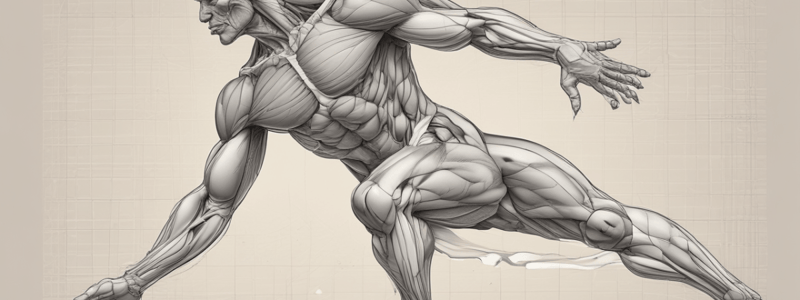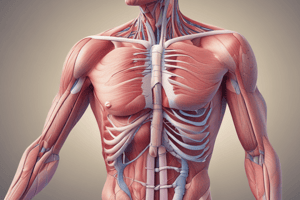Podcast
Questions and Answers
Which of the following muscle types produces fast contractions under voluntary control?
Which of the following muscle types produces fast contractions under voluntary control?
- Cardiac muscle
- Both cardiac and smooth muscle
- Smooth muscle
- Skeletal muscle (correct)
What is the ability of muscles to receive and respond to stimuli?
What is the ability of muscles to receive and respond to stimuli?
- Elasticity
- Excitability (correct)
- Extensibility
- Contractility
Where can smooth muscle be found in the body?
Where can smooth muscle be found in the body?
- Viscera and blood vessels (correct)
- Trunk of the body, head, neck, and extremities
- The heart
- All of the above
What percentage of body mass is made up of cardiac and smooth muscle?
What percentage of body mass is made up of cardiac and smooth muscle?
What is the characteristic of skeletal muscle that allows it to return to its original shape after being stretched?
What is the characteristic of skeletal muscle that allows it to return to its original shape after being stretched?
What is the primary way in which skeletal muscle is stimulated?
What is the primary way in which skeletal muscle is stimulated?
Which of the following is NOT a function of muscles?
Which of the following is NOT a function of muscles?
What is the primary characteristic of Type 2B muscle fibers?
What is the primary characteristic of Type 2B muscle fibers?
What is the role of troponin in the muscle contraction process?
What is the role of troponin in the muscle contraction process?
What is the function of the myosin heads in the muscle contraction process?
What is the function of the myosin heads in the muscle contraction process?
Which of the following is connective tissue extending from the epimysium which surrounds each fascicle?
Which of the following is connective tissue extending from the epimysium which surrounds each fascicle?
What is the characteristic of the I bands in the myofibrils?
What is the characteristic of the I bands in the myofibrils?
What is the function of actins' attachment to Z disks in the sarcomere?
What is the function of actins' attachment to Z disks in the sarcomere?
What is the primary source of energy for Type 1 muscle fibers?
What is the primary source of energy for Type 1 muscle fibers?
Which of the following is a thin cell membrane which encloses skeletal muscle fibers (cells)?
Which of the following is a thin cell membrane which encloses skeletal muscle fibers (cells)?
What is the composition of the thin filament?
What is the composition of the thin filament?
What is unique about the appearance of Type 1 muscle fibers?
What is unique about the appearance of Type 1 muscle fibers?
What is the location of the M-line in the sarcomere?
What is the location of the M-line in the sarcomere?
Why do dog muscles have a strong oxidative capacity?
Why do dog muscles have a strong oxidative capacity?
Which type of muscle fiber is most suitable for prolonged activity?
Which type of muscle fiber is most suitable for prolonged activity?
Which of the following is the basic contractile unit within striated muscle fibers, giving them the appearance of striations?
Which of the following is the basic contractile unit within striated muscle fibers, giving them the appearance of striations?
What is the function of the titin filamentous molecules?
What is the function of the titin filamentous molecules?
What is the characteristic of the A bands in the myofibrils?
What is the characteristic of the A bands in the myofibrils?
In which type of muscles is myoglobin primarily found?
In which type of muscles is myoglobin primarily found?
Which of the following is a sheath of connective tissue surrounding skeletal muscle?
Which of the following is a sheath of connective tissue surrounding skeletal muscle?
What is the characteristic that distinguishes Type 2A fibers from Type 2B fibers?
What is the characteristic that distinguishes Type 2A fibers from Type 2B fibers?
What is the role of myoglobin in relation to reactive oxygen species?
What is the role of myoglobin in relation to reactive oxygen species?
What percentage of cytoplasmic proteins does myoglobin constitute?
What percentage of cytoplasmic proteins does myoglobin constitute?
Which type of muscle fiber has a mix of oxidative and glycolytic metabolism?
Which type of muscle fiber has a mix of oxidative and glycolytic metabolism?
What is the primary characteristic that distinguishes Type 1 muscle fibers from Type 2 muscle fibers?
What is the primary characteristic that distinguishes Type 1 muscle fibers from Type 2 muscle fibers?
Which of the following is connective tissue extending from the perimysium which surrounds individual muscle fibers and is attached to the sarcolemma?
Which of the following is connective tissue extending from the perimysium which surrounds individual muscle fibers and is attached to the sarcolemma?
What is the primary function of mitochondria in muscle cells?
What is the primary function of mitochondria in muscle cells?
Which of the following is a small bundle or cluster of muscle fibers (cells)?
Which of the following is a small bundle or cluster of muscle fibers (cells)?
What is the role of myoglobin during periods of intense muscular activity?
What is the role of myoglobin during periods of intense muscular activity?
Which type of muscle fibers have a larger proportion of mitochondria?
Which type of muscle fibers have a larger proportion of mitochondria?
What is the purpose of T Tubules in muscle fibers?
What is the purpose of T Tubules in muscle fibers?
What determines the total amount of myoglobin in the body?
What determines the total amount of myoglobin in the body?
What is the location of T Tubules in mammalian sarcomeres?
What is the location of T Tubules in mammalian sarcomeres?
What is the composition of myoglobin?
What is the composition of myoglobin?
Which type of muscle fibers have a larger sarcoplasmic reticulum?
Which type of muscle fibers have a larger sarcoplasmic reticulum?
Flashcards are hidden until you start studying
Study Notes
Muscles: General Information
- Muscles are contractile tissue with functions of locomotion, respiration, digestion, swallowing, parturitions, blood and lymphatic circulation, and generating body heat.
- Muscles have properties of contractility, excitability, extensibility, and elasticity.
- There are three main types of muscles: skeletal muscle, cardiac muscle, and smooth muscle.
Muscle Types
- Skeletal muscle makes up 70% of body mass and produces fast contractions under voluntary control.
- Skeletal muscle can be found in the trunk of the body, the head, neck, and extremities.
- Skeletal muscle has striations.
- Smooth muscle produces slow contractions under involuntary control and can be found in viscera and blood vessels.
- Smooth muscle lacks striations.
- Cardiac muscle produces fast contractions under involuntary control and can be found in the heart.
- Cardiac muscle has striations.
Skeletal Muscle: General Info
- Skeletal muscle is crucial for body movement as it is attached to bones via tendon, where it moves and supports the skeleton.
- Skeletal muscle is considered to be under voluntary response because it is stimulated by motor nerves.
- The thin filament composition consists of 2 intertwined helical strands of actin protein and 2 strands of tropomyosin protein.
Troponin
- Troponin is located intermittently along the tropomyosin-actin strand.
- Troponin has an affinity for calcium ions.
Thick Filaments
- The thick filament is myosin.
- The myosin filament contains a tail of intertwined helices and 2 globular heads, where 1 head binds to ATP and the other binds to actin.
- Myosin heads can flex and relax.
- Myosin acts as an ATPase enzyme by using ATP as the source of energy for contractions.
- Approximately 500 myosin heads form cross-bridges that interact with actin to shorten the sarcomere.
Titin Filamentous Molecules
- Titin filamentous molecules keep myosin and actin filaments in place.
- Titin filamentous molecules are very elastic filamentous molecules with 1 end attached to the end of the Z disk and another part attached to myosin.
Myofilament: Organization
- Myosin and actin filaments partially interdigitate, resulting in the myofibrils to have alternating light and dark bands, also known as striations.
- I bands are the light bands (thin filaments) which are isotropic to polarized light.
- A bands are the darker bands (thick filaments) which are anisotropic to polarized light.
- The end of actin filaments are attached to Z disks (AKA: Z lines), forming the periphery of the sarcomere and transversely bisecting the I bands.
- The H-zone is the light line in the center of the sarcomere from the thick filaments.
- The M-line is composed of thick filaments and accessory proteins and can be found inside the H-zone, forming the center of the sarcomere.
Skeletal Muscle: Fiber Types
- Type 1 (slow) muscle fibers are red fibers.
- Type 1 fibers are slow twitch oxidative muscle fibers, meaning they highly rely on oxidative metabolism.
- Type 1 fibers are slow contracting and fatigue-resistant.
- Type 1 fibers are rich in mitochondria, myoglobin, and capillaries, which cause this fiber type to have a red appearance.
- Type 2 (fast) muscle fibers are white fibers.
- Type 2 muscle fibers are fast twitch glycolytic muscle fibers.
- Type 2 fibers are fast contracting and are more fatigable fibers, in comparison to Type 1 fibers.
- Type 2 fibers rely on glycolytic metabolism and have less mitochondria than Type 1 fibers.
- Type 2 fibers lack myoglobin, causing it to have a white pigmentation.
- Type 2 muscle fibers can be further classified as "Type 2A" and "Type 2B".
- Type 2A fibers use mixed oxidative-glycolytic metabolism and are fast contracting with fatigue resistance.
- Type 2B fibers use glycolytic metabolism and are fast contracting, fast-fatiguing fibers.
Muscle Cell: Organelles
-
Sarcoplasmic Reticulum is a specialized endoplasmic reticulum which manages calcium storage, release, and reuptake, aiding in muscle contraction.
-
The sarcoplasmic reticulum is larger in cells with faster contracting fibers, such as the Type 2 (white) fibers.
-
Mitochondria is present in large numbers within muscle cells and lay parallel to myofibrils.
-
Mitochondria is more prevalent within slow fibers, such as Type 1 (red) fibers.
-
Mitochondria supplies the contracting myofibrils with large supplies of ATP to be used for energy.
-
T Tubules are tubules that contain periodic invagination within the sarcolemma and are arranged transversely to myofibrils.
-
T Tubules contain ECF (extra cellular fluid).
-
T Tubules allow the plasma membrane of the muscle fiber to carry depolarization of action potentials to the interior of the muscle fiber.
-
In mammals, T Tubules are located at junctions between A bands and I bands of the sarcomere (2 per sarcomere in longitudinal view).
-
Each T Tubule is flanked by 2 terminal cisternae of the sarcoplasmic reticulum, resulting in the formation of triad structures.
Myoglobin
- Myoglobin is a protein composed of a single polypeptide chain with only 1 HEME group (also known as an oxygen binding site).
- Myoglobin is located primarily in the striped muscles of vertebrates and is found exclusively in skeletal and cardiac muscle.
- Myoglobin constitutes up to 5-10% of all cytoplasmic proteins.
- Myoglobin serves as a local oxygen reservoir where it can temporarily provide oxygen whenever blood oxygen supply is low during periods of intense muscular activity.
- Myoglobin can also function in the homeostasis of nitric oxide and the detoxification of reactive oxygen species.
Studying That Suits You
Use AI to generate personalized quizzes and flashcards to suit your learning preferences.




